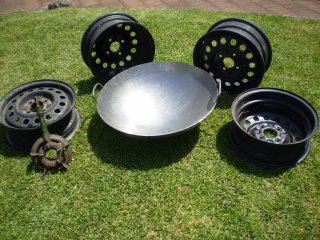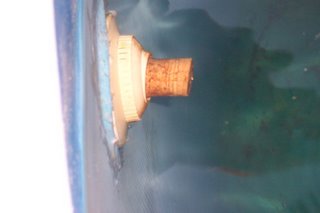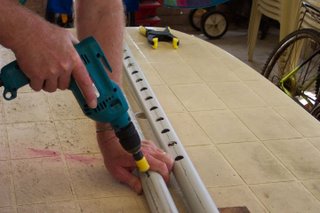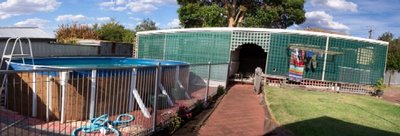Wednesday, January 03, 2007
Wok cooker complete
 The rims have been tack welded together and an opening has been cut into the side by first drilling holes in each corner and then using an angle grinder to cut between them. This opening is for the gas ring. A series of notches were cut around the top so that hot air could escape up the sides of the wok. This is important for the burner to work properly. A few more holes were drilled into the sides of the rims to act as air intakes.
The rims have been tack welded together and an opening has been cut into the side by first drilling holes in each corner and then using an angle grinder to cut between them. This opening is for the gas ring. A series of notches were cut around the top so that hot air could escape up the sides of the wok. This is important for the burner to work properly. A few more holes were drilled into the sides of the rims to act as air intakes. 
Monday, January 01, 2007
Outdoor Wok cooker
 Since visiting the Port Fairy Folk Festival and seeing a large wok being used to make a lovely Paella, we have had this idea that this could be a good arrangement for a party. Being able to serve a Paella or a noodle dish, eg Singapore Noodles would be pretty cool.
Since visiting the Port Fairy Folk Festival and seeing a large wok being used to make a lovely Paella, we have had this idea that this could be a good arrangement for a party. Being able to serve a Paella or a noodle dish, eg Singapore Noodles would be pretty cool.Some time ago we saw and purchased a large wok. It cost us $60 and measures about 610mm in diameter and 200 deep.
Recently I purchased 4 wheel rims from Gambier Contracts at $2 each. These measure 415mm in diameter and the wok sits nicely in them.
While we were at Gambier Contracts an acquaintance was purchasing a second hand BBQ and as we had just upgraded ours we offered our old one to him. He was working on a project to organise a BBQ for his church and so was glad of our offer and dropped by to pick it up straight away. Between the second hand one and our old one he will make a great unit. I showed him my plans for a wok cooker and he offered me a gas burner as he had an old one that he didn’t want.
My plan is to tack weld the rims together to make a stand and fit the burner into the top rim. I will notch out some vents around the top of the rim, add a coat of pot belly black paint and I reckon that we will have a great outdoor cooking device that won’t look to shabby and will work well.

Saturday, October 21, 2006
Grey water through the dunny
Wednesday, October 04, 2006
First Day of operations

The plumbing was allowed to sit overnight to ensure that the adhesives used had cured properly. The following morning the pump was switched on with the tap in the open position. The the tap was slowly moved toward the closed position until we could hear water moving through the pipes. Lots of air was shot into the pool as the solar collector filled with water. Then the tap was moved into the closed position.
Two of the drip-loc fittings produced bubbles, from the detergent lubrication, as air was forced out of the system. I was concerned that some might leak but not even a drip from one of the fittings. Fantastic.

So I left the system on for about 4 hours from midday to 4:00pm. The original pool temperature was 14 degrees celcius and by 4:00pm had climbed to 16 degrees. According to the Elders weather site the day's maximum was 23 degrees. I also compared the temperature of the pool water with that coming out of the solar collector. The solar collector was adding almost 2 degrees to the temperature of the water.
While all of that was happening I covered over the pipe and straightened up the poly tubing as best I could.
I did not need to purchase further components. I had 1.5 lengths of PVC pipe left over.
PROJECT: Solar pool heater.
Tuesday, October 03, 2006
Complete the plumbing

Having sealed the pool I could cut the pipe that returns the filtered water back to the pool and complete the plumbing to the solar collector manifolds. I fitted the Tee pieces and the tap into this pipe. My idea is that when the tap is in the off position, water from the filter is forced through the solar heat collector (bottom pipe) through the lower manifold and the heated water is returned via the top manifold to the pool via the top pipe.

PROJECT: Solar pool heater.
Keep the water in the pool

Now it was time to complete the plumbing from the manifolds to the pool. We needed to keep the water in the pool which was achieved using a bath plug in the skimmer box and sparkling wine cork in the outlet that returns water to the pool.

PROJECT: Solar pool heater.
Fit poly tubing

I lay the bottom manifold on the lower end of the roof close to the 11m mark. I did not fix this to the roof.
I had precut the tubing to 11m lengths on the ground. Two chalk marks on the driveway did the trick for getting even lengths.
These lengths required pushing onto the take off and then a screw cap is forced up over this spur to secure the pipe.
The day was not warm enough and so the pipe did not lay flat in the valleys of the corregations.
PROJECT: Solar pool heater.
Fit take offs

Fitting the take offs was a challenge. Some went in easier than others and by the time it came to putting in the 36th I had a system. Gentle pressure with a slight movement from side to side. Ensure that the grommet and take off are lubricated with some slightly diluted dishwashing detergent.
Watch your fingers.
PROJECT: Solar pool heater.
Fit Grommets

The holesaw left lots of roughness on the holes. I scraped these off, inside and outside and finished the holes off with a light sanding. I noticed that this made the fitting of the grommets easier when I campared it to the test hole that I had made in a bit of scrap pipe that I had not cleaned up. The other thing that helped was to use a bit of slightly diluted dishwashing detergent as a lubricant.
The grommets fit only one way. The grommets have a curved groove in them to allow for the curve of the PVC pipe.
Look carefully on the diagram from Drip-loc. There is small bevel of the grommet and this ends up on the inside of the pipe.
Take care that these grommets are set properly into the pipe. The inside of the grommet will be round if this is so.
PROJECT: Solar pool heater.
Drill the holes

I worked out that the valleys in corrogated iron roofing material are 75mm apart. My roof is a little over 3.5m wide and about 13m long. So to start making the two manifolds, I cut two lengths of the PVC pipe to 3m and then proceeded to mark 25mm centres.
Firstly I lay the pipe of the ground in a way that it would not roll around. I found a piece of 19mm board and rested a fine point texta onto it. I used this to make a line along the length of the pipe. Then I marked the 75mm centres.

I have 200m of poly tubing and wanted the length of these runs to be 11m long. This meant that I would only be drilling 18 of these holes in each manifold. I alalowed extra length on the manifold to allow for more poly runs to be added later if I needed or wanted.
PROJECT: Solar pool heater.
Drip-Loc instructions
Yesterday was solar pool heating construction day. Mike from the rural irrigation store gave me (way back at the time of purchaing the goods) a photocopy of some manufacturer specifications that were critical to making this project. I was using 19mm black poly tubing into 40mm pvc pipe (minimum allowed so it turns out for these fittings) and so needed a hole saw 22mm in diameter. It says to use slow speed hand drills - mine is variable speed which I can use at slow speed.
PROJECT: Solar pool heater.
Friday, April 07, 2006
Supplies have arrived
 The supplies have arrived and well within my initial price estimates. What’s the bet I’ve forgotten something?
The supplies have arrived and well within my initial price estimates. What’s the bet I’ve forgotten something?Key
1 - 40mm, Class 9 PVC pipe
2 - 19mm x 200m low density poly pipe
3 - PVC ball valve – 32mm
4 - 40mm PVC elbow
5 - 40mm PVC cap
6 - 50mm metal saddle
7 - Priming fluid and solvent
8 - Drip-loc Grommet takeoff 19mm
9 - 32mm PVC tee
10 - PVC coupling 40mm to 32mm
When we worked out exactly what we wanted Mike then did some calculations and said that he can supply 40mm for cheaper than 32mm. The existing pipe that returns water into the pool is 32mm.
As the drip loc fittings come in packets of 25, he did a really good price on two packets giving a total of 50 (only needed 32) rather than splitting them up. These particular19mm fittings will not work on PVC pipe less than 40mm in diameter anyway. If I used 16mm low density poly I could have used 32mm drip loc fittings. These are a weak point in the design IMHO – I hope that they don’t leak.
The price – plenty of change from $350. The lot cost $274 with GST. Huge Grin.
PROJECT: Solar pool heater.
Saturday, March 25, 2006
Solar Pool Heater
 I've been hunting around for a solar pool heater. I was staggered with their cost so I looked around for designs for a build your own heater. Not much available.
I've been hunting around for a solar pool heater. I was staggered with their cost so I looked around for designs for a build your own heater. Not much available.I want to put a black poly tubing heat collector on the roof of the carport in the background. I can lay black poly tubing in the valleys of the corrogated iron roof in lengths of about 12 metres. I could fit about 40 of these lengths on the roof. I will use a pair of saddles to secure each of the manifolds to the roof.
I went to a local rural irrigation store today to check out some options for making a manifold at both ends - PVC fittings or rural poly pipe fittings were my thoughts about options. Mike, the bloke in the shop was a great help. We quickly eliminated rural poly pipe fittings. T pieces in rural poly would cost about $25 each where as PVC fittings would be about $5.75. Mike then had an idea of using grommet fittings. For these you drill holes in the PVC pipe and then fit a grommet arangement to feed the poly tube from the PVC pipe. These are only about $1.60 each. I like this option for two reasons - it is cheaper and I will be able to use every valley in the iron. The size of the T pieces would mean that I might only be able to use every second valley. Mike was great value and so I will get my parts through his business - "Davison Drilling and Irrigation." As we live in town he reckoned that he would be able to organise the delivery of the pipe.
I will connect the manifolds to the pool inlet via PVC pipe. I need to research the diameter of the existing PVC supply pipe and use the same size for this project. To be nice to the pump, I could opt for a size larger but definitely not smaller.
I'll go back next weekend with an offcut of the pipe that I need. He gave me prices for 40mm diameter Class 6 PVC pipe. I might only need 32mm though I think. I need
- 44m of the PVC pipe - $15 for each 6m length
- 13 PVC elbows - did not find out - I expect maybe $4.50 each
- 2 PVC caps - $1.16 each
- 200 metre roll of 19mm diameter low density black poly tubing - $74
- 32 grommet arrangements - about $1.60 each
- 1 tap to suit the PVC pipe - $15
- 4 saddles
- PVC adhesive
Hopefully I will have change from $350.
PROJECT: Solar pool heater.




